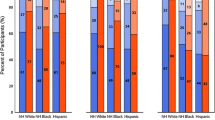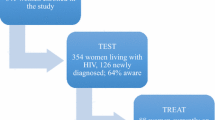Abstract
Russia has seen one of the world’s fastest-growing HIV epidemics. Transmission risk behavior, HAART-taking, and psychosocial distress of the growing population of Russian people living with HIV (PLH) in the HAART era are understudied. Participants of a systematically-recruited cross-sectional sample of 492 PLH in St. Petersburg completed measures of sexual and drug injection practices, adherence, perceived discrimination, and psychosocial distress. Since learning of their status, 58% of participants had partners of HIV-negative or unknown serostatus (mean = 5.8). About 52% reported unprotected intercourse with such partners, with 30% of acts unprotected. Greater perceived discrimination predicted lower condom use. A 47% of IDU PLH still shared needles, predicted by having no primary partner, lower education, and more frequently-encountered discrimination. Twenty-five percentage of PLH had been refused general health care, 11% refused employment, 7% fired, and 6% forced from family homes. Thirty-nine percentage of participants had probable clinical depression, 37% had anxiety levels comparable to psychiatric inpatients, and social support was low. Of the 54% of PLH who were offered HAART, 16% refused HAART regimens, and 5% of those on the therapy took less than 90% of their doses. Comprehensive community services for Russian PLH are needed to reduce AIDS-related psychosocial distress and continued HIV transmission risk behaviors. Social programs should reduce stigma and discrimination, and promote social integration of affected persons and their families.
Similar content being viewed by others
References
UNAIDS. Fact Sheet: Eastern Europe and Central Asia. December, 2009. Geneva: UNAIDS. http://data.unaids.org/pub/FactSheet/2009/20091124_FS_eeca_en.pdf. Accessed 27 Feb 2010.
Human Rights Watch. Lessons not learned: Human rights abuses and HIV/AIDS in the Russian Federation. 28 April 2004, D1605. http://www.hrw.org/sites/default/files/reports/russia0404.pdf. Accessed 27 Feb 2010.
Amirkhanian YA, Kelly JA, McAuliffe TL. Psychosocial needs, mental health, and HIV transmission risk behavior among people living with HIV/AIDS in St Petersburg, Russia. AIDS. 2003;17:2367–74.
United Nations Office on Drugs and Crime, Vienna. World drug report 2009. New York: United Nations. 2009. http://www.unodc.org/documents/wdr/WDR_2009/WDR2009_eng_web.pdf. Accessed 27 Feb 2010.
Federal Scientific Methodic Center for HIV Fight and Prevention. VICh-infektsiya: Informatsionnyy Byulleten’ [HIV infection: informational bulletin] (in Russian) No. 33. Moscow: Federal Scientific Methodic Center for HIV Fight and Prevention. 2009. http://www.hivrussia.org/files/bul_33.pdf. Accessed 27 Feb 2010.
Federal Scientific Methodic Center for HIV Fight and Prevention. The amount of HIV-infected persons in Russia by October 31, 2009. http://www.hivrussia.org/stat/2009/10.shtml. Accessed 27 Feb 2010.
UNAIDS/WHO Working Group on Global HIV/AIDS and STI Surveillance. Epidemiological fact sheet on HIV and AIDS, Russian Federation: 2008 update. Geneva. December, 2008. http://apps.who.int/globalatlas/predefinedReports/EFS2008/full/EFS2008_RU.pdf. Accessed 27 Feb 2010.
Federal Service for Surveillance of Consumer Rights Protection and Human Well-Being of the Russian Federation. Country progress report of the Russian Federation on the implementation of the declaration of commitment on HIV/AIDS, Moscow. 2008. http://www.unaids.ru/files/publications/UNGASS%20report%20Russia%202008_EN.pdf. Accessed 27 Feb 2010.
Centers for Disease Control and Prevention. HIV/AIDS Surveillance Report, 2007. Vol. 19. Atlanta: US Department of Health and Human Services, Centers for Disease Control and Prevention. 2009. http://www.cdc.gov/hiv/topics/surveillance/resources/reports/2007report/default.htm. Accessed 27 Feb 2010.
Kissin DM, Zapata L, Yorick R, et al. HIV seroprevalence in street youth, St. Petersburg, Russia. AIDS. 2007;21(17):2333–40.
Kalichman SC, Rompa D, Cage M. Sexually transmitted infections among HIV seropositive men and women. Sex Transm Infect. 2000;76:350–4.
Crepaz N, Marks G. Towards an understanding of sexual risk behavior in people living with HIV: a review of social, psychological, and medical findings. AIDS. 2002;16:135–49.
Rotheram-Borus MJ, Lee M, Zhou S, et al. Variation in health and risk behavior among youth living with HIV. AIDS Educ Prev. 2001;13:42–54.
Fogarty L, Roter D, Larson S, Burke J, Gillespie J, Levy R. Patient adherence to HIV medication regimens: a review of published and abstract reports. Patient Educ Couns. 2002;46:93–108.
Weinhardt LS, Kelly JA, Brondino MJ, et al. HIV transmission risk behavior among men and women living with HIV in four US cities. J Acquir Immune Defic Syndr Hum Retrovirol. 2004;36:1057–66.
Kalichman SC. Co-occurrence and treatment nonadherence and continued HIV transmission risk behaviors: implications for positive prevention interventions. Psychosom Med. 2008;70:593–7.
Sikkema KJ, Watt MH, Drabkin AS, Meade CS, Hansen NB, Pence BW. Mental health treatment to reduce HIV transmission risk behavior: a positive prevention model. AIDS Behav. 2010;14:252–62.
Glass TR, Battegay M, Cavassini M, et al. Longitudinal analysis of patterns and predictors of changes in self-reported adherence to antiretroviral therapy: Swiss HIV cohort study. J Acquir Immune Defic Syndr. 2010;54:197–203.
Johnson MO, Charlebois E, Morin SF, Remien RH, Chesney MA. Effects of a behavioral intervention on antiretroviral medication adherence among people living with HIV: the healthy living project randomized controlled study. J Acquir Immune Defic Syndr Hum Retrovirol. 2007;46:574–80.
Radloff LS. The CES-D scale: a self-report depression scale for research in the general population. Appl Psychol Measure. 1977;1:385–401.
Radloff LS, Locke BZ. The community mental health assessment survey and CES-D scale. In: Weissman MM, Myers JK, Ross CE, editors. Community surveys of psychiatric disorders. New Brunswick, NJ: Rutgers University Press; 1986. p. 177–87.
Kalichman SC, Rompa D, Cage M. Distinguishing between overlapping somatic symptoms of depression and HIV disease in people living with HIV/AIDS. J Nervous Mental Dis. 2000;188:662–70.
Spielberger CD. State-trait anxiety inventory (form Y). Palo Alto, CA: Consulting Psychologists Press; 1983.
Cutrona CE. Ratings of social support by adolescents and adult informants: degree of correspondence and prediction of depression symptoms. J Personality Soc Psychol. 1989;57:723–30.
Cutrona CE, Russell DW. The provisions of social relationships and adaptation to stress. Adv Personal Relationships. 1987;1:37–67.
Kelly JA, Murphy DA, Bahr GR, et al. Factors associated with severity of depression and high-risk sexual behavior among persons diagnosed with human immunodeficiency virus (HIV) infection. Health Psychol. 1993;12:215–9.
Kelly JA, Murphy DA, Bahr GR, et al. Outcome of cognitive-behavioral and support group brief therapies for depressed HIV-infected persons. Am J Psychiatry. 1993;150:1679–86.
Paterson DL, Swindells S, Mohr J, et al. Adherence to protease inhibitor therapy and outcomes in patients with HIV infection. Ann Intern Med. 2000;133:21–30.
García de Olalla P, Knobel H, Carmona A, Guelar A, Lopez-Colomes JL, Cayla JA. Impact of adherence and highly active antiretroviral therapy on survival in HIV-infected patients. J Acquir Immune Defic Syndr Hum Retrovirol. 2002;30:105–10.
Ladnaya NN. Key epidemiological indicators and trends of HIV infections in the Russian Federation. Report of the Federal Scientific-Methodological Center for Prevention and Fight With AIDS, 30 Sep 2010.
Dieffenbach CW, Fauci AS. Universal voluntary testing and treatment for prevention of HIV transmission. JAMA. 2009;301:2380–2.
FrontAIDS. ARV therapy in Russia: barriers to treatment delivery. Alternative report to UN General Assembly Special Session on HIV/AIDS. 2008. http://www.icaso.org/resources/Shadow_russia1107ru.full%20report.pdf. Accessed 27 Feb 2010.
The HIV/TB Study Writing Group. Mortality from HIV and TB coinfections is higher in Eastern Europe than in Western Europe and Argentina. AIDS. 2009;23:2485–95.
Acknowledgment
Conduct of this research and preparation of the paper were supported by grants P30-MH52776 and R24-MH082471 from the U.S. National Institute of Mental Health. The authors thank the study participants and also Anastasia G. Kuyanova, Rudolph A. Amirkhanian, Maria Donskaya, and Roman A. Khoursine at ICART; Aza G. Rakhmanova, Svetlana V. Zhukova, Irina D. Yevseyeva, and Vladislav N. Koryagin at the Botkin Hospital for Infectious Diseases; Natalya V. Bodosova, Elena V. Stepanova, Olga V. Koltsova, and Olga N. Leonova at the AIDS Center, Infectious Disease Hospital #10 and PLH self-support groups in St. Petersburg; and Ruzanna Aleksanyan, Timothy L. McAuliffe, Tom Lytle, Anton M. Somlai, David W. Seal, Steven D. Pinkerton, Michelle Anderson-Lamb, and Allan C. Hauth at the Medical College of Wisconsin for their assistance in the research.
Author information
Authors and Affiliations
Corresponding author
Rights and permissions
About this article
Cite this article
Amirkhanian, Y.A., Kelly, J.A., Kuznetsova, A.V. et al. People with HIV in HAART-Era Russia: Transmission Risk Behavior Prevalence, Antiretroviral Medication-Taking, and Psychosocial Distress. AIDS Behav 15, 767–777 (2011). https://doi.org/10.1007/s10461-010-9793-x
Published:
Issue Date:
DOI: https://doi.org/10.1007/s10461-010-9793-x




